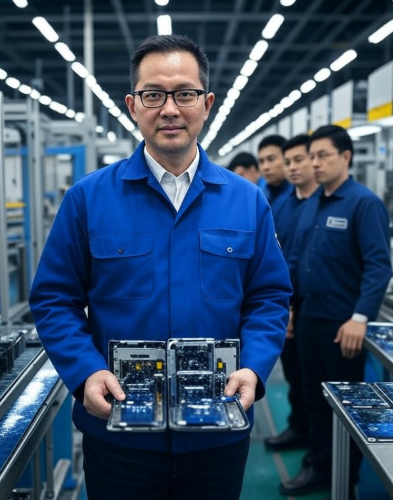Introduction
On May 24, 2025, Reuters reported that President Donald Trump threatened a 25% tariff on Apple for iPhones sold but not made in the U.S., reigniting a decade-long debate about reshoring iPhone manufacturing. This move highlights a pressing global concern often seen in Google’s “People Also Asked\” section: why is it so difficult to manufacture iPhones in the United States, and what are the broader implications for global supply chains? The hurdles – ranging from economic costs to logistical complexities and geopolitical tensions have sparked skepticism about the feasibility of U.S.-made iPhones. This blog explores these challenges and proposes actionable solutions to make domestic iPhone production a reality, balancing economic viability with national interests.
The Problem: Why US-Made iPhones Face So Many Hurdles
The push to bring iPhone manufacturing to the U.S. is driven by a desire to create jobs and reduce reliance on foreign supply chains. However, the reality is far more complex, as numerous barriers make this goal difficult to achieve, a topic frequently discussed in global online searches.
1. Economic Costs and Consumer Price Impacts
One of the most significant hurdles is the economic cost of manufacturing iPhones in the U.S. Currently, iPhones are assembled in China by partners like Foxconn, where labor costs are low about $3.63 per hour, compared to the U.S. minimum wage in states like California at $16.50 per hour. Analysts estimate that moving production to the U.S. could increase iPhone prices to $3,500, up from the current $1,200 for top models. This price surge, driven by higher labor costs and the need to build new factories, would lead to “massive demand destruction,” as noted by Wedbush Securities. Consumers globally are unlikely to accept such a steep increase, posing a significant barrier to reshoring.
2. Complex Global Supply Chain Dependencies
The iPhone’s supply chain is a global web, involving over 700 production sites and 2,700 components sourced from countries like South Korea (displays by Samsung/LG), Japan (flash memory by Kioxia), and Taiwan (chips by TSMC). China’s manufacturing ecosystem, built over decades, ensures proximity and coordination among suppliers, enabling rapid production. Replicating this in the U.S. would take a decade, as experts suggest, and require importing many parts, which would still face Trump’s proposed tariffs. This global dependency makes it nearly impossible to produce a fully U.S.-made iPhone without significant delays and cost increases, a challenge often highlighted in online discussions.
3. Lack of Skilled Labor and Infrastructure
The U.S. lacks the specialized manufacturing workforce and infrastructure needed for iPhone production. In China, Foxconn employs over 300,000 workers at its Zhengzhou facility, many working grueling 12-hour shifts for $420–$690 monthly. American workers are unlikely to accept such conditions or wages, with factory jobs seen as tedious and dangerousev evidenced by past Foxconn worker suicides in 2010. Additionally, the U.S. has a shortage of tool and die makers and electronics engineers, critical for high-precision tasks like assembling “little screws,” which Commerce Secretary Howard Lutnick noted would need automation not yet available at scale. This labor and infrastructure gap is a recurring concern in global searches about U.S. manufacturing.
4. Geopolitical and Legal Challenges
Trump’s tariff threat leverages the International Emergency Economic Powers Act (IEEPA), allowing economic action after declaring an emergency. However, legal challenges, such as the ongoing case by 12 states in the Manhattan-based Court of International Trade, question IEEPA’s tariff authority. If upheld, this could empower Trump to impose tariffs, but experts warn that targeting only Apple would give competitors like Samsung an unfair advantage, undermining the goal of reshoring. Geopolitically, tariffs on parts from Asia could strain relations with allies like South Korea and Japan, further complicating Apple’s supply chain and raising global concerns about trade wars.

The Solution: A Strategic Path to US-Made iPhones
Despite these hurdles, a strategic approach can make U.S.-made iPhones feasible, addressing economic, logistical, and geopolitical challenges while aligning with national goals. Here’s how Apple and the U.S. government can collaborate to overcome these barriers.
1. Gradual Transition with Hybrid Manufacturing
Rather than an abrupt shift, Apple should adopt a hybrid manufacturing model, starting with small-scale production in the U.S. while maintaining Asian operations. Apple’s experience with Mac Pro production in Austin, Texas, since 2019 shows this is possible, though limited in scale. By assembling a small percentage of iPhones say 5%, similar to India’s iPhone 14 production Apple can test domestic capabilities without disrupting its global supply chain. This gradual approach mitigates cost spikes, allowing time to develop infrastructure and train workers, addressing the global concern of economic feasibility.
2. Investing in Automation and Workforce Development
To tackle labor costs and shortages, Apple should invest heavily in automation, as suggested by Tim Cook’s comments to Howard Lutnick about needing robotic arms for precision at scale. Developing this technology in the U.S. could create high-skilled jobs for mechanics and electricians, aligning with Trump’s vision of job creation. Simultaneously, the U.S. government should fund workforce development programs, partnering with companies like Intel, which offers semiconductor certification courses, to train electronics engineers and factory workers. This dual focus on automation and education addresses the global question of how to build a skilled manufacturing workforce in the U.S.
3. Building a Domestic Supply Chain with Incentives
The U.S. government should offer tax incentives and subsidies to encourage domestic production of iPhone components. For instance, TSMC’s Arizona factory, which began producing chips for Apple, could expand with federal support, reducing reliance on Asian imports. Apple should also collaborate with U.S. firms like Corning (for Gorilla Glass) and Broadcom to localize more parts production. While rare earth minerals, predominantly sourced from China, remain a challenge, the U.S. could invest in alternative sources or recycling programs to secure materials like neodymium and lanthanum. This strategy addresses the global concern of supply chain dependency, fostering a more self-sufficient manufacturing base.
4. Navigating Geopolitical Challenges Through Diplomacy
To mitigate geopolitical tensions, the U.S. should negotiate tariff exemptions with allies like South Korea and Japan, ensuring Apple can import critical components without penalties. Diplomatically, the U.S. could position domestic iPhone production as a collaborative effort, inviting allied nations to invest in U.S. factories, similar to Canada’s involvement in Trump’s Golden Dome plan. Legally, Apple should lobby for clarity on IEEPA’s scope, advocating for tariffs that apply uniformly to all smartphone makers to avoid competitive disadvantages. This approach addresses global concerns about trade fairness and international relations.
5. Consumer Education and Price Transparency
To manage consumer expectations, Apple should launch a marketing campaign highlighting the value of U.S.-made iPhones supporting American jobs and reducing foreign dependency while being transparent about price increases. Offering financing plans or trade-in programs can offset the higher cost, estimated at $2,000–$3,500 per iPhone. By framing this as a patriotic investment in national security and innovation, Apple can maintain consumer trust, addressing the global question of how to balance cost with economic nationalism.
Challenges and Future Outlook
Implementing these solutions faces challenges. Automation technology may take years to scale, and workforce training requires significant investment. Geopolitically, negotiations with allies could falter if U.S. tariffs escalate tensions. Consumer acceptance of higher prices remains uncertain, as posts on X reflect skepticism about paying $3,500 for a U.S.-made iPhone. However, a phased approach, supported by government incentives and diplomatic efforts, can gradually make U.S. production viable, potentially reducing costs over time as infrastructure improves.
Conclusion
The hurdles to U.S. made iPhones – economic costs, supply chain complexities, labor shortages, and geopolitical tensions are formidable, as highlighted by Trump’s tariff threat on May 24, 2025. Yet, through a hybrid manufacturing model, investments in automation and workforce development, domestic supply chain incentives, diplomatic negotiations, and consumer education, Apple and the U.S. can overcome these challenges. This strategy not only addresses the global concern of reshoring manufacturing but also sets a precedent for balancing economic nationalism with global collaboration, ensuring that the iPhone remains a symbol of innovation, whether made in China or the U.S.



